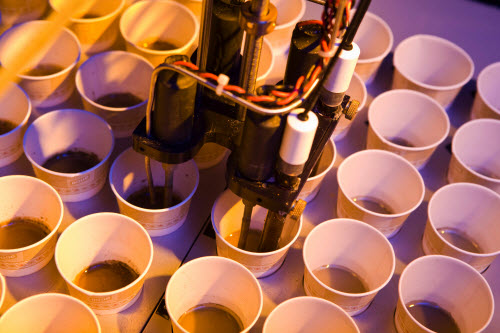Submittal Forms
Routine Soil Test
The routine soil test is the first step in planning and maintaining healthy soil. Following the University of Kentucky soil test recommendations leads to greater yields and quality crops. Routine soil testing helps reduce the guesswork in fertilizer and lime application.
Your report will show the amount of Phosphorus, Potassium, Calcium, Magnesium, Zinc, pH and buffer pH.
Organic matter
Soil organic matter is any material produced originally by living organisms that is returned to the soil and goes through the decomposition process. Soil organic matter aids in nutrient retention and is important to carbon sequestration and climate change. Knowing the organic matter content is of primary interest for special situations where soil tilth (physical condition of soil relating to plant growth) and water holding capacity are important.
Your report will show the amount of % Organic Matter.
Boron
The primary source of Boron is soil organic matter. Boron becomes available as plants go through the decomposition process. This test is helpful for alfalfa or red clover where regular application of B is recommended. If soil test exceeds 2 lb./A, boron should not be applied. There are other specific situations for commercial vegetable crops in which the Boron test may be helpful.
Your report will show the amount of Boron.
Micronutrients
This test serves as an addition to routine analysis. Micronutrient testing is ideally done along with a plant tissue analysis to help determine if a deficiency exists. The availability of micronutrients in the soil are most affected by soil pH and organic matter. Yield response to micronutrient fertilization is not common.
Your report will show the amount of Boron, Copper, Iron and Manganese.
Soluble Salts
This analysis applies to fields that receive heavy application of fertilizer, have poor drainage, or have poor plant growth under regular watering conditions. Customers who manage turfgrass (golf courses), have crops in high tunnel production, or manage a field with irrigation would benefit from this test.
Your report will show electrical conductivity.
Presidedress Nitrate Test (PSNT)
The Presidedress Nitrate Test (PSNT) is a test used for optimizing nitrogen fertilizer use for corn grain and corn silage. It measures the amount of nitrate nitrogen available in the soil at the time when the crop is most likely to start using it. This nitrogen is a by-product of the mineralization of manure and/or last year's forage legume crop, and its availability is influenced by soil temperature and moisture.
Your report will show nitrate-nitrogen.
Heavy Metals
Agricultural soils normally contain low levels of heavy metals. Contamination from industrial activities or byproducts can increase the natural levels of heavy metals in soil. Fertilizers and other soil amendments also add small amounts of heavy metals to the soil, which can build up over time with repeated applications.
Your report will show the amount of Cadmium, Chromium, Copper, Lead, Nickel and Zinc.
Soil Texture
Soil texture is a basic property of soil that affects soil water holding capacities, water and air movements, pore sizes and plant root growth. It is defined by percentage of sand, silt and clay in the soil.
Your report will show the amount of Sand, Silt, Clay and Textural Class.
Potential Acidity with Routine Soil Test
Potential Acidity is a test designed for mine spoils with a significant concentration of reduced sulfur that releases acidity upon oxidation. A routine soil analysis is not adequate to quantify the amount of lime required to neutralize all of the potential acidity from reduced sulfides. Your report will include the lime required to neutralize the acidity in the top 6 inch layer of soil.
Tests primarily used for Research
Research Submittal Form
Note: This is a list of the most common tests. See the submittal form for additional tests.
Total Nitrogen
Total nitrogen analysis measures N in all organic and inorganic forms. Total nitrogen does not indicate plant-available N. Total N is not used for fertilizer recommendations.
Cation Exchange Capacity, Bases & Base Saturation
Cation exchange capacity is a measure of the negative charge in the soil that can hold onto positively charged nutrients and soil acidity. The positively charged cations Ca, Mg, K, and Na are considered base cations. The percentage of the base cation charge to the cation exchange capacity is considered the base saturation. The UK soil report contains an estimate of CEC and base saturation from the routine soil test. A more accurate determination of CEC and base saturation can be obtained with this separate test.
Water Holding Capacity
Water holding capacity is the amount of water a soil can hold for crops use. Water is the most common limiting factor for many crops. Soil texture and organic matter are the key components that determine soil water holding capacity.
Calcium Carbonate Equivalence
This test determines calcium carbonate (CaCO3) content of soil. The test is utilized in mine spoils to determine how much lime is available to neutralize acidity from sulfur oxidation.
Brief descriptions of testing methods.

